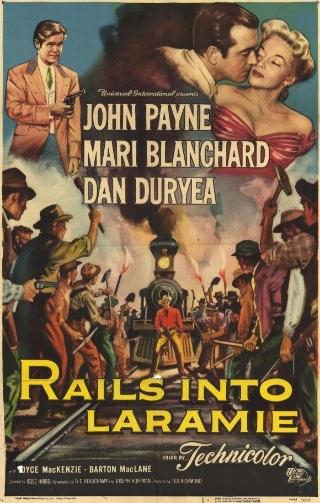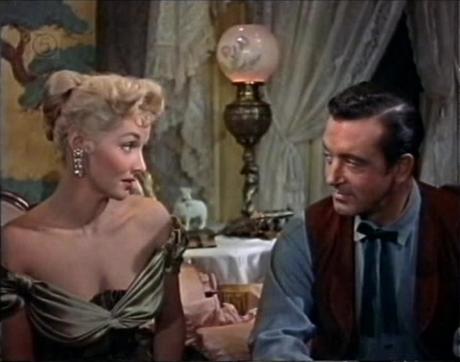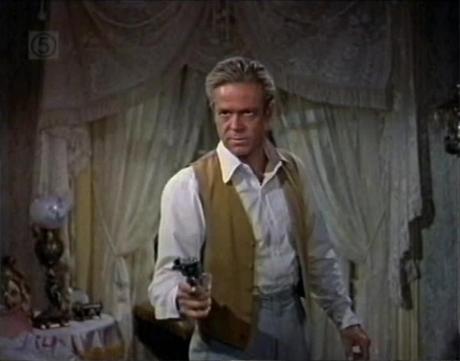
There are so many Universal-International westerns that you could pretty much run a blog devoted entirely to the studio’s output alone. With such an abundance of titles, it’s only natural that there should be a wide range in terms of type, budget and overall quality. Some had more spent on them, some featured significant amounts of location filming and some were shot largely on sets. Personally, I like them all, and can generally find something positive to take away from all varieties. Rails Into Laramie (1954) is one of the lower budget efforts, using stock footage and filmed on studio interiors for the most part. It’s a movie that eluded me for a long time and I want to express my gratitude to Jerry E for his help in ensuring I finally got around to seeing it.
The railway, that powerful symbol of westward expansion and the unstoppable advance of civilization, has been at the heart of many westerns. To chart the progress of the railroad is to chart the course of the American west itself so it’s obviously going to feature heavily in pictures set on the ever shifting frontier. When the iron horse appears to have stalled at the Wyoming town of Laramie questions arise as to why this should be so. Someone in Laramie has a vested interest in seeing the work come to a halt, some who’s making plenty of money out of the hard-drinking and hard living construction gangs. And so the army decide to send someone, just one man and not the detail of soldiers the local bigwigs have requested, to investigate and try to get the operation up and running again. The choice is Jefferson Harder (John Payne), a sergeant nearing the end of his stint in uniform but a man familiar with and comfortable among the kind of saloon detritus likely to be responsible for the delays. Harder isn’t exactly welcomed with open arms by Laramie’s dignitaries, partly due to their disappointment at not getting a full detachment and also because of his friendship with Jim Shanessy (Dan Duryea). Shanessy and Harder are old army buddies and former rivals for the affections of the former’s wife, Helen (Joyce Mackenzie). It’s clear enough from early on that Harder is going to have to go up against his friend as he’s the one behind the stoppages. What remains to be seen though is how he’s going to achieve much with virtually a whole town against him, the machinations of the slippery Shanessy to contend with, and the uncertain allegiance of saloon owner Lou Carter (Mari Blanchard).

One thing which immediately struck me when watching Rails Into Laramie was that there were a few passing similarities to the classic Destry Rides Again. There’s the basic set up of a corrupt town, the ignominious arrival of an improbable savior, the tough female saloon owner, and the leading role undertaken by women in the implementation of justice – and I’ll return to that last aspect presently. At least some of this can probably be attributed to the fact screenwriter D D Beauchamp also worked on Destry, George Marshall’s remake of his own 1939 original. All these elements are very welcome of course and add a lot to the entertainment of the piece, but there are problems, or weaknesses anyway, present in the script too. There are a few plot strands which are introduced and promise to be interesting yet are dropped almost immediately and lead nowhere in particular. There would appear to be potential for an added layer of conflict stemming from the triangle created by Payne, Duryea and Mackenzie, not to mention the allure of Blanchard drifting in the background. We learn that both men wanted Mackenzie in the past but that’s it, no more mileage is gained from that, or the possibility of Blanchard causing Duryea to consider straying. And then there’s the selection of an all female jury to try Duryea, an example of women’s rights which was ahead of its time compared to the rest of the country. Aside from the opportunity for further social comment, there was a suggestion that the women’s actions in participating in jury service would endanger their men. Again though, this is not followed up on and simply peters out.
I tend to think of Audie Murphy when Jesse Hibbs’ name comes up due to his having taken charge of a number of the star’s best films. Hibbs was one of those stable hands who could be relied upon to turn in a solid piece of work and that’s more or less what we get with Rails Into Laramie. There’s nothing flashy on show but it’s a competently directed film. With the so-so script, the responsibility on the performers is increased, though the likes of Payne and Duryea were quite capable in this respect. I’ve seen more of Payne’s noir work but he makes for a personable and convincing enough western lead too. There’s not so much of that bruised quality on display that he used to such good effect in film noir, still the toughness remains and you don’t doubt his ability when it comes to mixing it with the villains. Duryea could play charming, dissembling bad guys in his sleep and his role here honestly is a walk in the park for him. There’s not much physical threat posed by him, it’s more a behind the scenes schemer and fixer this time, and that aspect is left in the capable hands of a sneering and dangerous Lee Van Cleef. Of the two female performers Joyce Mackenzie had a largely thankless part, offering sympathy and support but seeing little development in her character. Mari Blanchard got dealt a far stronger hand and played it to the hilt too. She brings an edgy ambiguity to the part – leaving both Payne and Duryea (and the viewer too) unsure exactly what way she’s going to leap. Then there’s the marvelous James Griffith who adds such value to every film he appears in – I just saw him in a delightful little cameo in Kubrick’s The Killing the other day as it happens – and turns in one of the most memorable bits of work in the movie as the nervous but loyal marshal.

The last few years have seen more and more Universal-International westerns becoming available in various countries. However, Rails Into Laramie remains unreleased anywhere to the best of my knowledge. It’s a modest picture and it wouldn’t rank as one of the top tier efforts by the studio. Even so, it is solidly entertaining and I’d certainly appreciate a release. Again, my thanks to Jerry for making this piece possible.
